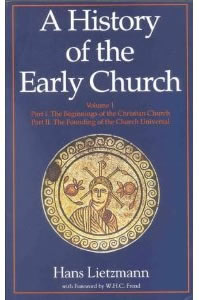Book Review
A History of the Early Church
by Hans Lietzmann

I had the great fortune of receiving this four volume set of early church history as a gift from a friend while working on my Ph.D. at the University of St. Andrews. Honestly, I did not realize at the time what a valuable gift I had been given.
Now you can purchase the four volume set in this single volume: an English translation of the work of Hans Lietzmann. Lietzmann was an excellent German scholar, known mainly for succeeding the great Adolf von Harnack and serving as the Chair for divinity studies at the University of Berlin (1924-1942).
Dietrich Bonhoeffer studied under Lietzmann, graduating in 1927 - my apologies if I seem overly nostalgic, but I can only imagine what it must have been like to be around Lietzmann, Bonhoeffer, Barth and others during this period. Lietzmann had the ability to communicate the problematic intricacies of early Christian history in a way that was easy to read and easy to understand. I do not read German, but have no doubt that Woolf's English translation reflects this excellent style.
Lietzmann followed Harnack's liberal views, yet I do not detect skepticism in his work. What is obvious is his desire to bring every piece of historical data into the discussion. These writings remain an excellent work for doing research as Lietzmann points the reader to original source documents and to solid secondary scholarship. A bonus and an indication is that WHC Frend has worked on this single volume. Frend's Rise of Christianity text joins this set of Lietzmann as one of three essential texts on the first several centuries of Christian history. I would add Chawick's single volume to this list.
This work of Lietzmann begins with a splendid discussion of the Roman empire to give the reader an historical backdrop. He then discusses the church, the New Testament (including many extrabiblical writings), second century critics and the apologists, and concludes with chapters on the dominant regions of the second century Church (Asia Minor, Gaul, Africa, Rome, Syria, and Egypt).
Lietzmann allows the early christian writings to speak for themselves. He offers critical commentary, but he does not assume (as is common among more modern historians) the ancients to be simpletons, only politically motivated, or fabricators. He does offer data that goes against the Catholic view, but he also presents data that conflicts with the Protestant views as well. In this more objective style, Lietzmann is a committed historian, presenting the data.
I want to give the potential buyer a taste of Lietzmann. This is a selection I will typically read aloud when lecturing on second century persecutions.
I want to end my simple review by stating that although Lietzmann followed the more liberal views of his tutor Harnack, the more conservative reader should not be afraid of this volume. You will be presented with historical data that any serious student of early Christianity MUST wrestle with - ALL data is good and must be faced. I would urge any serious student of early Christianity to purchase this volume. You will use Lietzmann for the remainder of your life - this work as already become a classic. And it will stand the test of time. This volume will be read and cited for the next 50 years.
R.A. Baker
Ph.D. Ecclesiastical History
In the year A.D. 177 a similar persecution broke out in Lyons and Vienne owing to popular passion, and these churches also wrote a letter about it to Asia Minor. The vivid descriptions in this letter arouse the deepest emotions in every new generation of readers. In this case, the Christians were genuinely hunted out: we can see the alarmed confusion in the churches; the first instances of torture spread terror abroad, a few recanted, the majority kept themselves timidly in the background, pagan slaves said what was required of them. Then the passion of the populace broke loose, the prison was filled with those who confessed themselves Christians, and all the torments of a brutal, murderous blood-lust broke upon the heads of the unfortunates. Then those who had at first recanted were once more arrested, and gained new courage when brought face to face with death. Pictures painted in blood glower dreadfully before our eyes. Bishop Potheinos at ninety years of age lay in prison, beaten by the fists and trampled by the feet of the mob, until death mercifully released him after two days. The slave girl, Blandina, hung on a cross, her body mangled and her bones broken, as food for wild beasts: to no purpose, for the beasts did not touch her, and so she ended her life on the funeral pyre. In the middle of the arena stood a chair glowing red hot holding the Christians in its Moloch-like arms: the smoke of the burning bodies rose to the sky, and unceasingly from all the places where the martyrs stood, the death cry sounded: I am a Christian, I am a Christian. In the prison, they lay in rows fixed helplessly in stocks, and died a silent death: their bodies provided useful food for the dogs. The executioner piled the pitiable remains into a heap, crowned by the heads of the decapitated Roman citizens: finally, the flames flared up and reduced everything to ashes, and these were thrown into the Rhone with scoffing laughter in order that the Christian hope of resurrection, too, might be destroyed.
In all these bloody terrors, however, the reflection of another world gleamed with light. Heaven opened for the Christians in their agony, Christ descended from His throne at the right hand of God where Stephen had seen Him at the moment of his own death, and spoke encouragement to them; all earthly torments paled before the blessedness of the vision of God. No more pain touched the souls of the blessed: their enraptured faces reflected the glory of the Lord as they left their human condition behind, and became like the angels. Hitherto they had bravely confessed their faith, but their entry into the other world conferred on them the dignity of "martyrs", "witnesses of God", who had warranted the truth of their testimony with their lives --- just as had been done by Christ, the "genuine and true witness," and their example. The Church of the earliest period insisted on reserving the title of martyr entirely for those who had suffered death for Christ: only by suffering thus was their witness made perfect.

Questions, Comments or Criticisms:
You can send an email to directly to me Al Baker, CH101.
CH101 retains the right to edit and post comments/questions unless you specifically ask that your comments NOT be posted. Comments that are personal or private are never posted...only questions about Church History, the Bible, etc.